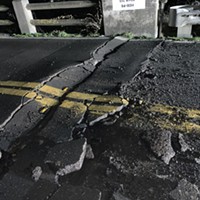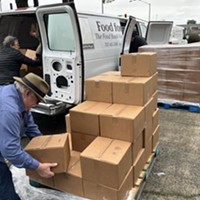Potato Gnocchi
"The district is called Bengodi ... and on a mountain, all of grated Parmigiano cheese, dwell folk that do naught else but make maccheroni and raviuoli, and boil them in capon's broth, and then throw them down to be scrambled for."
By Simona Carini[
{
"name": "Top Stories Video Pair",
"insertPoint": "7",
"component": "17087298",
"parentWrapperClass": "fdn-ads-inline-content-block",
"requiredCountToDisplay": "1"
}
]
"The district is called Bengodi ... and on a mountain, all of grated Parmigiano cheese, dwell folk that do naught else but make maccheroni and raviuoli, and boil them in capon's broth, and then throw them down to be scrambled for."
- Giovanni Boccaccio, Decamerone
With the term "maccheroni," Giovanni Boccaccio (1313-1375) described something similar to what we call gnocchi. It was probably the first type of pasta ever made: a mixture of flour and water (the flour from wheat, millet, farro) shaped into round dumplings that were then cooked in boiling water. The best-known version, made with potatoes, is fairly recent in historical terms, since potatoes did not become common in Italy until the 1800s. Unlike corn, whose cultivation spread rapidly after the initial introduction from the New World, potatoes were long viewed with diffidence and disdain. In time, however, the good qualities of the tuber, both in terms of nutrition and adaptability to different terrains, asserted themselves and the potato was enthusiastically embraced. What better proof of this wholehearted adoption than the induction of potatoes into the gnocchi tradition?
Gnocchi made with other main ingredients are still common in Italy. The small Sardinian malloreddusis made with semolina flour. Other gnocchi that are not flour-based are also common, like knödel, made with stale bread, and gnocchi di ricotta.
The strange-sounding word gnocchi traces its origin to the Latin term nucleus, from which nocchio, meaning gnarl,derived. In the dialect of the region around Venice nocchiobecame gnoco and from there it was an easy transition to gnocco and its plural gnocchi. I find it interesting that in 'gnarl' we find the same combination of consonants, gn, in which English speakers muted the g.
Potatognocchi are one of my mother's specialties. I have memories of our family doctor, Ivo, having lunch with us whenever my mother made the dish. My father had known Ivo since he was a child, so he was on particularly familiar terms with my family. When my brother or I were sick, he would visit us at home in the evening to diagnose our illness of the day. Tall and gentle, he was a reassuring figure in our life, even though his prescriptions were often less than delectable. Like so many things I grew up with, I took both our doctor and potato gnocchi for granted. Nowadays home visiting family doctors are dismissed as time-inefficient and gnocchi are discounted as too time-intensive. I believe we should reevaluate our relationship with time, and devoting a couple of hours to make and cook gnocchi might be a good starting point.
When I decided to prepare gnocchi at home in California, I wondered about the wisdom of asking my mother for her recipe, given the useless struggle I engaged in when I tried to get her recipe for polenta ("Talk of the Table," March 1). I decided to make an attempt anyway, and my mother left me speechless:
"One kilo of potatoes and 200 grams of flour."
Was I hearing this right? Had my mother actually used exact quantities and units of measure? Before I was able to recover from my stunned state, my mother started her usual list of don'ts: don't use eggs, don't use watery potatoes, and more. I let her finish her litany without trying to stop her, even though I had a clear memory of how to make gnocchi from observing her. I was never allowed to touch anything due to an early diagnosis of utter ineptitude, which fortunately turned out to be perfectly curable.
My mother's prescription translates into 2.2 lbs of russet potatoes and 1.5 cups regular flour. She boils the unpeeled potatoes, while I prefer to bake them to prevent any increase in humidity. I therefore use less flour and obtain, so I believe, lighter gnocchi. I pierce the potatoes in a few places and put them in the oven preheated to 400 degrees then bake them for 45-55 minutes, depending on their size, until a knife can easily cut through them. My mother insists that I peel the potatoes immediately, but I wisely wait until my hands can hold the tubers without being scorched. I then use a ricer to mash the potatoes. A potato masher works as well, but the ricer makes a dough of finer grain, which results in gnocchi of a more delicate and homogeneous texture.
After mashing the potatoes into a large bowl, I let them cool slightly, then sift 1 1/4 cup of flour over them, mixing it in with a wooden spoon. I pour the potato/flour mixture over a floured board and knead briefly. Overkneading may make the dough tougher, so I keep it to the minimum needed to obtain a uniform consistency, dusting extra flour to prevent the dough from sticking to the surface. I cut a fist-size piece of dough and roll it into a sausage-like string about 3/4" in diameter and use a knife to cut it into 3/4" long pieces. I then use my thumb to make an indentation in each piece. This is easily achieved with the help of the back of a cheese grater or the tines of a fork, and it gives gnocchi a rough surface in whose nooks and crannies the seasoning sauce finds refuge. As I make gnocchi I move them on a plate and keep going, fistful after fistful, until all dough is used.
Technically all this can be done in advance, but it is better not to let too much time pass between the making and the cooking. While I am cutting the gnocchi I bring a pot of water to a rolling boil. Once all the gnocchiare ready, I toss 12-15 of them into the water and wait until they all surface. This takes less than two minutes, so it is important that your attention does not wander. I use a slotted spoon to fish the floating gnocchi out of the pot and place them into a bowl covered with a tight lid so the gnocchi keep warm. I repeat the tossing-waiting-fishing routine until all gnocchi are cooked.
Potato gnocchi can be seasoned in many ways. My mother makes a simple tomato sauce with basil and I often do the same. The sauce is ready by the time I start cooking the gnocchi so nothing distracts me from the task at hand. Once all gnocchi are cooked, I drain the excess water from the bowl, pour in the sauce and add half a cup of freshly grated parmigiano, toss lightly with a spoon and serve immediately. Pesto is a delicious alternative. In this case, I put half a cup of pesto in the bowl where I then place the cooked gnocchi: Their warmth melts the cheese component of the pesto and the little water that drips from them makes a creamier sauce (my pesto is rather dense).
As it is clear from my description, preparing gnocchi requires a time commitment, but the reward is well worth the effort, as your taste buds and the smile on your guests' faces will readily attest. Once you become comfortable with the tossing-waiting-fishing routine, you can turn it into a pre-dinner performance for your guests that, I can assure you, works wonders as an appetizer.
If I have not managed to convince you to try your hand at making this "New World potato meets the oldest type of pasta" dish, you can always order it at a restaurant, like La Trattoria in Arcata or Cin Cin in Eureka. Now that you know how gnocchi are made, you will have a deeper appreciation for the work of the chef that brings those round delights to your plate.
Speaking of Food
more from the author
-
A Green Dish for Earth Day or Any Day
- Apr 18, 2024
-
Spreading Vegetable Joy
Beets for a colorful vegan starter
- Jan 18, 2024
-
A Daily Dose of Awe
- Jan 4, 2024
- More »


































